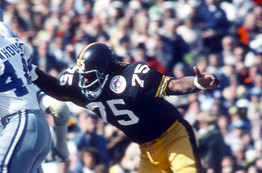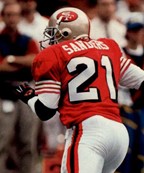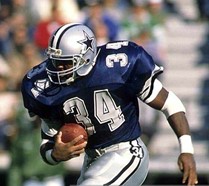Top Tips for Throwback NFL Jersey Collectors
Posted by Custom Throwback Jerseys on 4th Jan 2021
Collecting NFL football jerseys is a rewarding hobby for many sports fans across North America. Given the time and expense that goes into assembling a really first-rate collection, it’s important to do what you can to safeguard your investment. Here we’ll show you how to distinguish a fake jersey from the real thing; how to clean your jerseys in a way that avoids harming them; and how to store your collection properly at home.
How to Spot a Fake

Not all throwback jerseys are alike—some are made with loving care by dedicated professionals, while others are just cheap knockoffs made by sketchy companies. So how do you know which is which? When buying replicas, you can save yourself a lot of trouble by purchasing only from reputable companies, like Custom Throwback Jerseys. Other companies may have cheaper jerseys, but it’s important to keep in mind that, as the saying goes, you get what you pay for. If the price sounds too good to be true, it probably is.
But let’s say you’ve stumbled onto a jersey but aren’t certain where it came from. Is there a way to determine whether it’s the real deal? For the most part, yes. Low-quality knockoffs usually have certain characteristics that betray their true origins.
Although it goes without saying, poor quality is another characteristic of a fake jersey—but you might have to examine it a little before this becomes apparent. One element to look for is the tags; on fake jerseys, these tend to look crude, discolored, and badly sewn on. Poor stitching, often with many dangling threads, is a common characteristic of fake jerseys.
One of the big giveaways is the quality of the numbers on the jersey. A good, authentic jersey should have numbers that are flat—they don't protrude from the surface of the fabric. This will be clear if you run your fingers over them. Many fake jerseys have numbers that bear creases or “bunch up” here and there, creating an uneven surface.
Glossy, shiny-looking numbers are another giveaway. Real NFL jerseys don’t have numbers that look like that; instead, their numbers appear solid and clean.
The numbers should also be perfectly aligned. Crooked numbers is a pretty amateurish mistake that skilled counterfeiters know to avoid, but it still happens. By the same token, the letters on the name plate should be evenly spaced.
Some fake jerseys have inconsistent coloration. For instance, the ventilation panels of a fake jersey might not match the color of the rest of the fabric when it should.
If you’re dealing with an actual worn-on-the-field uniform supposedly once owned by an NFL player, you should look up pictures of team uniforms from that era to see if you can spot inconsistencies. There may be a design element on the uniform that isn’t historically accurate, like numbers in the wrong font; if so, you’re looking at a fake.
This is far from a complete exploration of real vs. fake jerseys. Just remember to do your research before you invest money in products like these.
How to Wash a Football Jersey

If you’re into collecting throwback jerseys, it’s natural to want to keep them in the best condition possible. That tends to involve washing your uniforms on a periodic basis. This is especially important if you’re into wearing your throwback uniforms out in public—and some of our customers do exactly that—but keep in mind that your jerseys tend to accumulate dust even when they’re just hanging up in your closet. That makes it important to clean them somehow.
However, you need to be careful when washing your jerseys, as improper cleaning techniques can damage the fabric and shorten the uniform’s lifespan. And it’s not just cheap, low-quality jerseys that need to be treated properly—even top-of-the-line apparel, like the kind we have here at Custom Throwback Jerseys, needs tender loving care.
With that said, here’s a brief guide to washing your jerseys:
Treat major stains before washing – If your jersey has accumulated stains—like, say, from that time you spilled your Coke all over it—it’s best to get rid of them ASAP, before they set in. First, use cold water to dampen the area where the stain is. Then put some soap or shampoo on the stain. Next, rub the stain (gently now) with a sponge. This should remove most of the stain.
Separate your clothing – If you can, wash your jerseys with no other clothing items. If you're washing your jerseys with other clothing, you need to be sure that you're not mixing incompatible apparel in your washing machine. Otherwise, you could end up with ugly streaks and color spots on your jerseys. For example, don't wash your jerseys with blue jeans, which tend to leave streaks on other types of clothing. White jerseys should not be washed with non-white clothing.
Clean the jerseys in a washing machine – Turn your jerseys inside out prior to placing them inside the washer. Be sure to wash your jerseys with cold or warm water, as hot water could cause harm to the fabric. Use neutral laundry detergent; powder is preferable to liquid. Also, put the wash setting on “Delicate” (if applicable) and the spin setting no higher than “Medium.”
Allow jerseys to dry naturally – Don’t put your jerseys in the dryer and please keep the steam iron away from them. Hang them on a clothesline or lay them out flat. Be aware that direct sunlight can bleach colored jerseys, so consider letting them dry in a shaded area.
Washing your jerseys too frequently will cause them to wear out prematurely, so be careful.
How to Store Your Jerseys

So what should you do with your jersey when you’re not wearing it or showing it off to your fellow sports fans? Some people just throw theirs in the closet somewhere, but you really should take a few precautions to extend the life cycle of your jerseys.
The key is to store your jerseys in a cool, dry environment—heat, humidity, and UV rays will age the material prematurely. If possible, lay out your jerseys flat and unfolded. The second-best option—because not everyone has the room to spread out their jerseys—is to roll up your jerseys. But you should avoid putting them inside plastic bags for extended periods of time. Plastic does not allow your jerseys to “breathe” and contains chemicals that can harm the fabric of your jerseys.
If you’re like a lot of Custom Throwback Jerseys customers, you want to put your collection on display. The most common way to do that is to hang it up on a wall.
There are multiple methods of putting your jerseys on a wall for display, the easiest involves simply using an ordinary plastic, felt, or wood clothes hanger or, alternatively, a curtain rod. Simply attach the hangar or rod to a wall with help from a Command Strip (by 3M) and you have an eye-catching decoration that shows off your devotion to your favorite player or team. Please note that you shouldn’t use a wire hanger or any kind that uses clips—these can put little “dents” in your jersey over time.
However, hanging your jersey out in the open like that will not protect it from dust and accidental contact. That’s one reason why some people elect to put their jerseys in shadowbox frames. Another reason is that properly framed jerseys look awesome. You can purchase specialized shadowboxes that are designed for displaying sports jerseys, or, if you’re the DIY type, you can make your own display case. Whichever option you select, be sure that your display solution has UV-resistant glass.
Fortunately, it’s not especially difficult to keep your throwback jerseys in tip-top shape. If you’re just starting out on your collecting journey, or if you want to expand your existing collection, you can find authentic NFL apparel right here at Custom Throwback Jerseys. We're proud to offer the best-quality NFL jerseys online.
